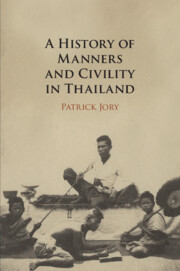Book contents
- A History of Manners and Civility in Thailand
- A History of Manners and Civility in Thailand
- Copyright page
- Dedication
- Contents
- Figures
- Acknowledgements
- Introduction: Manners and the Thai Habitus
- 1 Buddhist Ethics of Conduct and Self-Control
- 2 Manners and the Monarchy
- 3 The Making of the Gentleperson
- 4 Manners in a Time of Revolution
- 5 From Courtiers to Ladies
- 6 Royalist Reaction
- 7 The Passing of the Gentleperson
- Conclusion: Manners in Thailand’s Civilizing Process
- Bibliography
- Index
2 - Manners and the Monarchy
Prostration and Civilization
Published online by Cambridge University Press: 18 December 2020
- A History of Manners and Civility in Thailand
- A History of Manners and Civility in Thailand
- Copyright page
- Dedication
- Contents
- Figures
- Acknowledgements
- Introduction: Manners and the Thai Habitus
- 1 Buddhist Ethics of Conduct and Self-Control
- 2 Manners and the Monarchy
- 3 The Making of the Gentleperson
- 4 Manners in a Time of Revolution
- 5 From Courtiers to Ladies
- 6 Royalist Reaction
- 7 The Passing of the Gentleperson
- Conclusion: Manners in Thailand’s Civilizing Process
- Bibliography
- Index
Summary
This chapter looks at the history of prostration in Thailand. The practice appears to have been adopted from the Angkorean Empire of the Khmers and was used at the Kingdom of Ayutthaya. It examines the modes of etiquette that were required in royal audiences for both Thais and foreign visitors. The chapter argues that by the nineteenth century Europeans regarded such practices as slavish and 'uncivilized'. This led, in 1873, to the young new king, Chulalongkorn, issuing a famous edict abolishing the custom of prostration and replacing it with European modes of paying respect such as bowing. But while in public functions involving Europeans the new modes of paying respect were observed, privately the custom of prostration before one’s superiors continued with little change.
- Type
- Chapter
- Information
- A History of Manners and Civility in Thailand , pp. 40 - 66Publisher: Cambridge University PressPrint publication year: 2021

